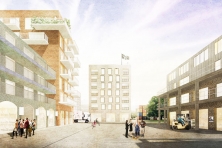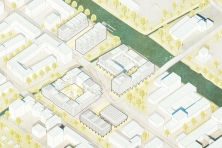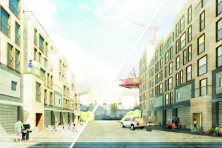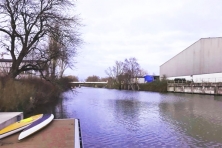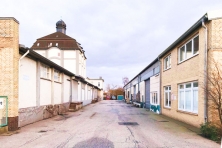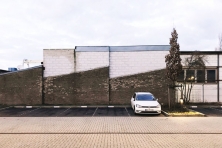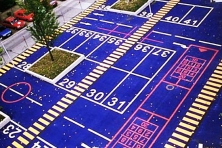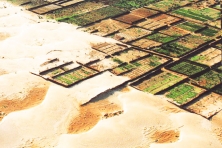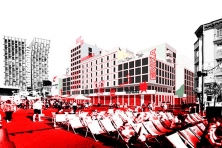DA/ -RIN -RUM -RUNTER -ZWISCHEN
Hamburg (DE) - Runner up
TEAM DATA
Team Representative: Robert Schnell (DE) – architect
Associates: Tobias Herr (DE), Paul Raphael Schägner (DE) – architects
Bernstorffstraße 120, 22767 Hamburg (DE)
+40 72376150 – info@herrschnell.com – herrschnell.com
See the complete listing of portraits here
See the site page here

T. Herr, P. R. Schägner & R. Schnell
INTERVIEW
Click on the images to enlarge
1. How did you form the team for the competition?
After studying together in Vienna (Robert + Paul), in Weimar (Tobias + Paul) and working together in Hamburg (Robert + Tobias), Tobias and Robert started their own architecture office. Paul works as an architectural nomad in between Germany and Korea. Sharing a special bond to Hamburg, we wanted to partake in this competition and the architectural discussion about Wilhelmsburg’s functional transformation.
2. How do you define the main issue of your project, and how did you answer on this session main topic: the place of productive activities within the city?
Even though, the real estate business of a growing city often pushes the space and productive economy out of the cities, there are special merits of the urban production. Urban production is more creative. Neighborhoods with social and functional heterogeneity are laboratories to innovation. We must mingle everything together, inspire one another and other urbanities to implement the paradigm of the productive city. We identified four different urban typologies with distinct spatial qualities. Within, around, underneath and in-between (da/ -rin, -rum, -runter, -zwischen), will become focal points of urbanity, where aspects of the productive, residential and cultural life interact, interweave and merge into symbiosis.
3. How did this issue and the questions raised by the site mutation meet?
We want the Elbinselquartier in Wilhelmsburg to be transformed into a sustainable way, to preserve local identity and aesthetics, to keep the existing businesses and local residents, and to forge a functional and social mix. The loosely packed neighbourhood, mix of production and housing, will be densified and enriched with spaces of social interaction and cultural innovation. Not a revolutionary, but an evolutionary densification shall create special places and make the planning area in Wilhelmsburg an inclusive and productive urban role-model.
4. Have you treated this issue previously? What were the reference projects that inspired yours?
We have treated this issue previously. Though the reality of our everyday architecture job is that we often have to create “striated” spaces, that clearly identify and separate functions to optimize their operation. Yet, we also love smooth spaces and the blurring of spatial and functional identities. Inspired by Deleuze’s texts about the polarity of smooth and striated spaces. We also love the streetscapes of Seoul’s “Golmokgil” (tiny roads) that show no design indicators to segregate user groups and a huge versatility of space borrowing techniques. This logic is exported to the Western World and manifests in project’s like Topotek’s “Spielparkplatz Fämingplatz”. We hope to create similarly active public spaces in our project, that we also enjoy in Hamburg’s functionally and socially heterogeneous neighbourhoods, like the “Sternschanze”, where we work.
Looking at recent projects in Hamburg, the functional transformation of the Kolbenschmidt-Gelände is a role model, that will further enhance Hamburg’s urban productivity. Also the project "Spielbudenplatz“ that tries to “Knack” the “St. Pauli Code” is not revolutionary, but an evolutionary and inspiring project. It is a drastic architectural transformation, but tries to be inclusive in the social, functional and aesthetical realm of the city. To ask for a local code or DNA and further strengthen the existing community seem to be at the core of the job of an architect.
Also our project elaborates architectural design strategies to implement the paradigm of the productive cities in an inclusive urban transformation process with smooth and striated spaces.
5. Urban-architectural projects like the ones in Europan can only be implemented together with the actors through a negotiated process and in time. How did you consider this issue in your project?
The Elbinselquartier in Wilhelmsburg is in a constant and currently more intensified transformation process that will negotiate various interests, approaches and ideas. Taking part in this architectural activation process with old and new inhabitants and many interesting collaborators, seems like wonderful thing to do. Our design proposal is not only an exemplary architectural concept but also a concrete building solution. We hope to get further involved in the transformation of the competition planning site and to further develop our design strategies.
6. Is it the first time you have been awarded a prize at Europan? How could this help you in your professional career?
It is the first time that we participate and we are very happy to have won a prize. As young architects working in Hamburg and abroad, we are happy to get to know some of the important actors of Hamburg’s architectural decisions making. They have been leading a highly qualitative architectural evolution of Hamburg in the recent decades. We hope to support and partake this cause of developing Hamburg’s urban and architectural qualities.
